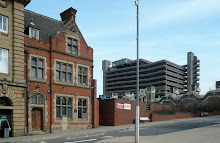
Eric Bainbridge 'The Mind Of The Artist At The Beginning Of Time', 1996, Mixed Media, 89 x 142 x 57 cm. Courtesy the artist and Workplace Gallery, UK
Royal Academy of Arts
Modern British Sculpture
Main Galleries
22 January – 7 April 2011
Royal Academy of Arts
Burlington House, Piccadilly
London W1J OBD
www.royalacademy.org.uk
Exhibition Preservation Partner: American Express Foundation
Supported by The Henry Moore Foundation
In 2011, the Royal Academy of Arts will be presenting the first exhibition for 30 years to examine British sculpture of the twentieth century. The show will represent a unique view of the development of British sculpture, exploring what we mean by the terms British and sculpture by bringing the two together in a chronological series of strongly themed galleries, each making its own visual argument.
The exhibition will take a fresh approach, replacing the traditional survey with a provocative set of juxtapositions that will challenge the viewer to make new connections and break the mould of old conceptions.
Key British works include: Alfred Gilbert Queen Victoria, Phillip King Genghis Khan, Jacob Epstein Adam, Barbara Hepworth Single Form, Leon Underwood Totem to the Artist, Henry Moore Festival Figure, Anthony Caro Early One Morning, Richard Long Chalk Line, Julian Opie W and Damien Hirst Let's Eat Outdoors Today.
Through these and other works, the exhibition will examine British sculpture's dialogue within a broader international context, highlighting the ways in which Britain's links with its Empire, continental Europe and the United States have helped shape an art that at its best is truly international in scope and significance. The selection of works is not limited to the British Isles, but looks outward at Britain in the world including sculpture from Native American, Indian, and African traditions. These will be represented by a series of significant loans from the British Museum and the V&A, which will be shown alongside modern British sculptures from the period 1910-1930 to highlight the inquisitiveness of British artists when the Empire was at its peak and London was, almost literally, the centre of the world.
The selection will also explore the choices constantly faced by the sculptor: the choice between figuration and abstraction; a choice that highlights the inherent tension in sculpture between its commemorative and political functions. Key juxtapositions exemplify these choices, including the striking comparison between Phillip King's Genghis Khan and Alfred Gilbert's Queen Victoria and Edwin Lutyens' Cenotaph and Jacob Epstein's Cycle of Life that opens the exhibition. Another juxtaposition encapsulates the choice between abstraction and figuration as represented by the work of Barbara Hepworth and Henry Moore, and tells of the emergence of British sculpture as a brand on the international stage in the post-war era.
The exhibition will show how, for over 100 years, London and its museums have had a powerful appeal for sculptors, and how the Royal Academy itself has played a significant and controversial role in shaping modern British sculpture.
ORGANISATION
Modern British Sculpture has been organised by the Royal Academy of Arts. The exhibition has been curated by Dr Penelope Curtis, Director of the Tate Britain, and sculptor Keith Wilson, in conjunction with Dr Adrian Locke, Exhibitions Curator, Royal Academy of Arts.
DATES
Press View: Tuesday 18 January, 10am – 2pm
Open to public: Saturday 22 January – Thursday 7 April
10am – 6pm daily (last admission 5.30pm)
Late night opening: Fridays until 10pm (last admission 9.30pm)
TICKETS
Tickets are available daily at the RA. Advance bookings: Telephone 0844 209 0051 or visit www.royalacademy.org.uk. Group bookings: Groups of 10+ are asked to book in advance. Telephone 020 7300 5995, fax 020 7300 5781 or email groupbookings@royalacademy.org.uk
For public information, please print 020 7300 8000 or www.royalacademy.org.uk
Royal Academy of Arts, Burlington House, Piccadilly, London W1J OBD
*Image above:
Arts Council Collection, Southbank Centre, London © Boyle Family / DACS 2010.
